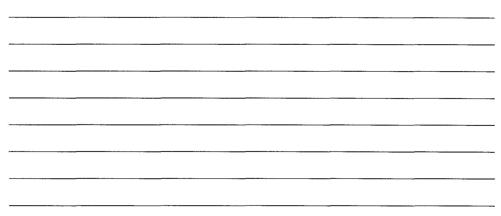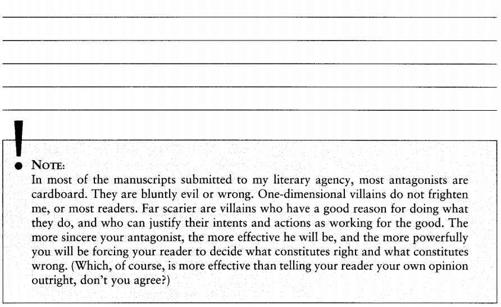Writing the Breakout Novel Workbook (40 page)
Read Writing the Breakout Novel Workbook Online
Authors: Donald Maass

Step 3: |
 |

Follow-up work: |
 |
Conclusion: Just as it is advisable to strengthen your theme, it is also no problem to run counter to it. Does your hero rescue his family from the wilderness, struggling against nature? What about the hermit who helps them? He lives at peace with nature, yes? His struggle may be the opposite: to connect again with his fellow man.
_________EXERCISE
Making the Antagonist's Case
Step 1:
What does your antagonist believe in? Why does he feel justified and right? How would the world be better, through his eyes, if things ran the way he would like them to run?
Write down your answers.

Step 2: |
 |
Step 3: |
 |
Follow-up work:
Find the moment in your story when your protagonist realizes that your antagonist is right, and why.
Write out that moment in a paragraph, starting now.

Conclusion:
Certainly you want your hero to doubt himself at times, don't you? Why not push that all the way and let your hero doubt himself in the extreme? What would be the circumstances? How close to failure does your protagonist come? In that moment, you will be very close to your core values and theme.
Symbols
S
ymbols, which sometimes go by their more academic name, objective correlatives, are another literary device that feels old-fashioned. The very word takes you back to high school English class, doesn't it? Soon we will be discussing stream of consciousness, litotes, parallelism, and syllepsis, eh?
In their simplest form, though, symbols are anything outward that stands in for anything inward or abstract, such as a mood or an idea. A statement like "He was in turmoil" can feel blunt. Instead, we might substitute an image; say, "Outside, the Siberian Elms held their heads in their hands and swayed, wailing like a chorus of Greek women." The image is indirect, but it nevertheless conveys an inner state.
Symbols can be glaringly obvious, of course. Think sunsets and trains rushing into tunnels. At their best, though, they are elegant and evocative. Their effect can be subliminal, barely noticed. A device they may be, but they also can be quite powerful.
One of the most accomplished novels of recent years is Barbara Kingsolver's story of an American missionary family's journey to the Belgian Congo in the 1960s,
The Poisonwood Bible.
This acclaimed saga is itself, among other things, a bible of breakout fiction technique. Kingsolver's rotating narrators are the four daughters of the Price family, and each is an outstanding example of character delineation. The distinctive voices of Rachel, Leah and Adah (twins), and Ruth May are instantly recognizable.
Kingsolver also masterfully sketches a cast of secondary African characters, whose depths are suggested even while their culturally different way of thinking ultimately is unknowable to the Prices. The girls' father, fundamentalist preacher Nathan Price, is a fully developed antagonist, tragically dedicated and unable to grasp the impossibility of his mission. The complications faced by the family steadily escalate as the local villagers' mistrust of Nathan Price grows and the Congolese prepare to wrest their country from the brutal grip of Belgium. The novel's many narrative threads are woven together with impeccable care.
There is so much to admire in
The Poisonwood Bible,
in fact, that fiction
writers studying Kingsolver's breakout technique might overlook her deft use of symbols. They can be found all the way through. Even the novel's extended opening image, narrated in flashback by the girls' mother, Orleanna Price, uses the image of a wild okapi stopping to drink in a jungle stream during a family outing. This is a multi-layered symbol for Orleanna's bewilderment at the mystery and beauty of the environment around her, and also for her own essential helplessness:
She [Orleanna] is inhumanly alone. And then, all at once, she isn't. A beautiful animal stands on the other side of the water. They look up from their lives, woman and animal, amazed to find themselves in the same place. He freezes, inspecting her with his black-tipped ears. His back is purplish-brown in the dim light, sloping downward from the gentle hump of his shoulders. The forest's shadows fall into lines across his white-striped flanks. His stiff forelegs splay out to the sides like stilts, for he's been caught in the act of reaching down for water. Without taking his eyes from her, he twitches a little at the knee, then the shoulder, where a fly devils him. Finally he surrenders his surprise, looks away, and drinks. She can feel the touch of his long, curled tongue on the water's skin, as if he were lapping from her hand. His head bobs gently, nodding small, velvet horns lit white from behind like new leaves.
It lasted just a moment, whatever that is. One held breath? An ant's afternoon? If was brief, I can promise that much, for although it's been many years now since my children ruled my life, a mother recalls the measure of the silences. I never had more than five minutes' peace unbroken. I was that woman on the stream bank, of course. Orleanna Price, Southern Baptist by marriage, mother of children living and dead. That one time and no other the okapi came to the stream, and I was the only one to see it.
Have you ever spent 258 words developing a symbol? Kingsolver does that here, to highly poetic effect. In fact, part of what makes her symbols poetic is that all of them emerge from the natural environment around her characters. Nathan Price's garden provides many of them. Price plants his seeds in a flat rectangle of soil, failing to understand that torrential afternoon downpours will swamp the garden; he should, instead, mound the earth around each plant. Sure enough, the rains make a lake of his Eden patch.
Then, one day early in their stay in the remote village of Kalinga, the Price family finds a nest of baby birds fallen from a hibiscus bush. The baby birds have drowned in the garden. Kingsolver does not belabor the image, but, even so, its effect is felt. Can there be any doubt that Nathan Price's rigid ignorance will have tragic consequences for his children? Later, the poisonwood tree in their yard gives Nathan a hideous, itching rash, and the meaning is the same: Nathan Price is messing with a place he does not understand or respect.